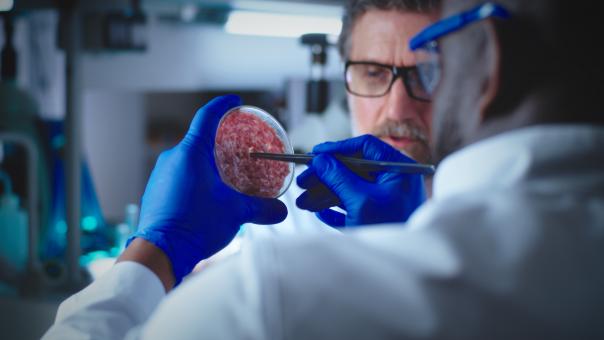
Huge innovations have been made within the plant-based meat sector over the last few years, which is now estimated to be worth £6.3bn, with predictions that will double by 2027. Early last year, McDonald’s launched its McPlant Burger in the UK and Ireland, demonstrating the extent to which plant-based meats have penetrated the market.
In 2022 it was estimated that there were 8m vegans worldwide, with 14% of Britons alone are choosing to live meat-free . This shift to plant-based diets and alternative food choices suggests the future of the plant-based meat market looks bright.
To create the meat-free alternatives there has been considerable research into what ingredients can be used. The challenge has been not just to ensure a similar tasting product but to create something that is nutritious.
Some of the ingredients used in plant-based meat include: pea protein, soya, coconut oil, vital wheat gluten, beans, nuts, tempeh, tofu, and vegetables.
Beyond Meat burgers, for example are predominantly made up of pea protein, coconut oil and rice protein, while Impossible Foods base their version on soy protein and coconut oil.
Ingredients like beetroot are often used to colour and create the ‘bleeding effects’ that real meat has, though questions over the nutritional benefits of such practices have been raised on occasion.
What does the future hold?
CB Insights suggests algae could be the next big thing. They require less land, less water and produce fewer greenhouse gas emissions than animal protein. They grow continuously and can be harvested in greater numbers than other source of plant-based protein.
The World Economic Forum recently calculated that producing 1kg of beef-sourced essential amino acids requires 148,000 litres of freshwater and 125 sq m of fertile land. To produce the same amount from the microalgae nannochloropsis oculate, raised in an open pond with brackish water, requires only 20 litres of freshwater and 1.6 sq m of non-fertile land.
However, there are a number of obstacles. Of the 20,000 known algae species, only four have been cleared for human consumption in the European Union: freshwater species chlorella and spirulina, and marine species odontella and tetraselmis chuii. Approval is both complicated and expensive.
Algae are also expensive compared to soya protein – at round £15.9 a kilo as against versus £1.20 for soybeans. However, with the increase in consumer demand production capacity is growing and this should bring down costs. As with lab-grown meat, supply would have to grow very quickly and the process would have to be highly scalable to drive down costs and prices.
And what could be the environmental consequences of using algae at scale? Palm oil is in many ways more sustainable than similar alternatives, but is now cultured at the cost of rainforest ecosystems.
Another popular trend in plant-based protein sources is chickpea protein. Chickpeas are rich in amino acids, iron, fibre and contain 6 grams of protein per half cup. They provide a nutrient rich alternative to meat. Hippeas, for example, has created chickpea-based crisps as a healthier alternative to potatoes, and chickpea protein flour can be used in plant-based burgers, chicken nuggets and sausage alternatives.
Anyone for laboratory-grown meat?
An alternative to plant-based ‘meat’ is artificially grown meat derived from animal stem cells. Cell-based or lab-grown products are made from real animal cells but are grown in a food production plant instead of taken from animals raised in captivity and slaughtered for consumption.
It is already available to consumers in Singapore where ‘cultivated chicken bites’ are currently the only approved lab-grown meat for sale. However, new developments are on the horizon. Lab-grown crab meat, for example, is expected to be on the Singaporean market later this year.
Lab-grown meat aims to provide a solution to the ethical and environmental concerns associated with the traditional methods of farming animals for meat. However until it is produced large-scale the impacts of lab-grown meat cannot be fully assessed.
This is particularly the case with the vast amounts of energy needed to process the meat, which could mean it creates more long-term greenhouse gas emissions than farming. There remains much debate over the ethics of this meat. Furthermore, the costs associated with mass production of lab-grown meat are large and the challenge continues to produce it to scale at affordable price continues.
Even if technology overcame these issues, this product’s origin cannot be forgotten. Lab-grown or not, it is meat and carries some of the same implications of consuming meat as the traditionally raised product. For those who want to refrain from meat, plant-based protein alternatives will continue to lead the way in plant-based food innovation.
Fish and seafood alternatives
As the Spoonshot ‘Trends for 2023 and Beyond’ report highlights, while there has been great innovation within meat and dairy alternatives, there are limited options available of free-from fish and seafood.
With fish a popular meal choice due to its health benefits, it is not surprising that global fish consumption has doubled since 1998 and is projected to nearly double again by 2050. It is vital that a more sustainable seafood alternative is found. Current alternative fish products feature ingredients such as jackfruit, soybeans, peas and green lentils, but there is huge scope for development of viable fish-less alternatives that sustainably meet taste and nutritional expectations.
Sea farms, where sea plants are grown in place of fish, grains and meat, could be one option. They may not offer the ‘faux fish’ products consumers are looking for, but ingredients such as seaweed, kelp and samphire would be sustainably farmed and harvested.
Zostera marina is a seagrass grown without freshwater or fertiliser, the grains from the seagrass are gluten-free and have nutritional value. They absorb carbon 35 times faster than tropical rainforests, making them a potential tool in fighting climate change and introducing more sustainable ways to source food.